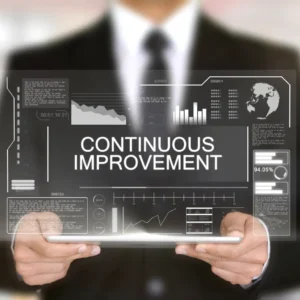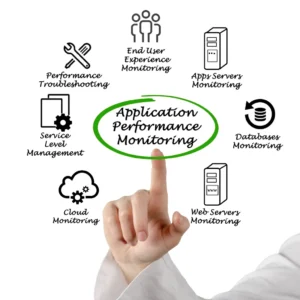
Agile Mastery in IPA
Navigating Success Through Continuous Improvement and Retrospectives
Welcome to the exploration of “Implementing Agile Methodology in Intelligent Process Automation (IPA).” In this insightful journey, we delve into the dynamic realm of IPA, where cutting-edge technology meets strategic agility.
The article focuses on fostering efficiency and adaptability through Agile methodologies, a critical approach in today’s ever-evolving business landscape.
Our focus is on Continuous Improvement and Retrospectives, which are essential components in ensuring the sustained success of IPA initiatives. We carefully examine every facet, from strategic frameworks and comprehensive criteria to adaptive protocols and user-centric design principles.
We delve into the intricacies of promoting a culture of continuous improvement, conducting effective retrospectives, and harmonizing automation with human oversight.
Join us in deciphering the key strategies, protocols, and frameworks that drive success in IPA development, emphasizing ethical practices, transparency, and compliance with industry standards.
Whether you are a business leader or a technical solution provider, this exploration promises valuable insights for navigating the complexities of Agile in the context of IPA implementation.
Agile Project Planning and Prioritization
Mastering Agile Project Planning and Prioritization in IPA Initiatives
In the realm of Intelligent Process Automation (IPA), mastering Agile Methodology is pivotal for success. This article navigates through strategic frameworks, meticulous criteria, and adaptive protocols, shaping streamlined project planning and prioritization in IPA initiatives.
Crafting a Strategic Framework ensures purpose-driven Agile planning, aligning projects with business goals and objectives for synergized automation efforts. Meticulous Criteria guarantee alignment with business goals, ensuring successful IPA implementation.
Protocols for Prioritizing Automation Workflows adapt to dynamic business needs and stakeholder input, fostering flexibility. Maintaining the delicate balance between automation and human oversight requires Rigorous Agile Planning and identifying optimal integration points.
Dynamic Assessment is crucial for swift adaptation to evolving business requirements and technological advances, ensuring sustained efficiency. Governance Frameworks uphold ethical and transparent Agile Project Planning, fostering accountability.
Proactive Measures ensure flexibility and responsiveness, allowing Agile teams to adapt swiftly to challenges and opportunities. Adaptive Protocols tailor Agile Planning to varied automation scenarios, embracing customization.
User-centric design Principles elevate stakeholder engagement during Agile Planning, optimizing overall user experience. Adherence to Agile Project Planning Standards and Best Practices is non-negotiable, safeguarding IPA implementation integrity for sustainable success.
Scrum Framework in IPA Development
Navigating Scrum in Intelligent Process Automation (IPA) Development
Within Intelligent Process Automation (IPA), the Scrum framework emerges as invaluable. This article illuminates strategic guidelines for its implementation in IPA development.
A Strategic Framework is foundational, ensuring seamless integration with broader organizational objectives; the guidelines aid in forming efficient cross-functional teams and maximizing diverse skill sets within Scrum.
Protocols for Agile Sprint Planning and Execution are pivotal, streamlining processes for unique IPA demands. Achieving harmony between Automation and Human Oversight is guided by rigorous Scrum principles, optimizing efficiency.
Dynamic Assessment ensures adaptability, seamlessly aligning the Scrum framework with evolving business objectives and technological trends in IPA. Ethical governance is ensured through Governance Frameworks, maintaining integrity in development endeavours.
Proactive Measures promote collaboration and communication within Scrum teams, enhancing productivity. Adaptive Scrum Protocols are tailored to diverse automation scenarios and business environments, enabling flexibility.
User-centricity takes precedence with Design Principles, optimizing overall experiences within Scrum. Compliance with Scrum Framework Standards guarantees successful integration, fostering sustained success in IPA development. In navigating Scrum, these guidelines promise a strategic, adaptive, and compliant approach for unparalleled success in IPA development landscapes.
User Stories and Requirements in IPA
Crafting Agile Success: User Stories and Requirements in IPA Implementation
User stories and requirements are pivotal in the Intelligent Process Automation (IPA) landscape. This article delves into the strategic framework, comprehensive criteria, and adaptive protocols for defining and incorporating these elements in an agile IPA environment.
Embarking on IPA initiatives requires a strategic framework, acting as a compass to align the agile journey with overarching business objectives. Crafting automation workflows with precision is guided by Comprehensive Criteria, ensuring clarity and purpose in eliciting and documenting user stories and requirements.
User feedback is a valuable asset seamlessly integrated through a protocol for incorporating it. Harmony between automation and human oversight is an art achieved through a rigorous definition of user stories and requirements, optimizing the strengths of both elements.
Dynamic Assessment ensures adaptability, facilitating the evolution of user stories and requirements to meet evolving business needs. Governance Frameworks are indispensable, ensuring ethical and transparent implementation and fostering trust in IPA initiatives.
Proactivity becomes a cornerstone with Proactive Measures, ensuring alignment with business objectives and anchoring IPA initiatives in purpose. Adaptive Protocols acknowledge diverse needs, tailoring user stories and requirements for varied automation scenarios.
Prioritizing User-Centric Design Principles optimizes the development life cycle, fostering a seamless and engaging experience. Lastly, adherence to Compliance Standards and Best Practices fortifies the integrity of IPA implementation, ensuring sustained success in this dynamic realm.
Sprint Planning and Execution
Mastering Agile Efficiency: Sprint Planning and Execution in IPA Projects
This article effectively explores the essential roles of sprint planning and execution in Intelligent Process Automation (IPA). Navigating through a strategic framework, comprehensive criteria, and adaptive protocols tailored for success in IPA initiatives, the journey unfolds.
The Strategic Framework becomes the cornerstone, seamlessly integrating sprint planning and execution into IPA initiatives. Precision is paramount in agile sprint planning, guided by comprehensive criteria that ensure alignment with business goals and automation objectives.
Protocols for Iterative Execution within defined sprint cycles drive systematic and efficient development processes. Achieving harmony between automation and human oversight is an art mastered through Rigorous Sprint Planning and Execution Strategies, optimizing the strengths of both elements.
Critical to success is Dynamic Assessment, ensuring adaptability to evolving business requirements and sustaining relevance in IPA projects. Governance Frameworks ensure ethical and transparent practices, fostering trust in sprint planning and execution within IPA initiatives.
Proactivity takes the lead with Proactive Measures, ensuring efficiency and effectiveness in agile sprint execution, fostering a streamlined and productive development process. Adaptive Protocols acknowledge the diverse needs of varied automation scenarios, promoting flexibility.
Prioritizing User-Centric Design Principles optimizes the stakeholder experience during sprint planning and execution. Lastly, adherence to Compliance Standards and Best Practices fortifies the integrity of IPA implementation, promising sustained success in this dynamic landscape.
Continuous Integration and Testing in IPA
Streamlining Excellence: Continuous Integration and Testing in IPA Workflows
Integrating continuous integration and testing is pivotal in Intelligent Process Automation (IPA). This article guides through a strategic framework, comprehensive criteria, and adaptive protocols, providing essential guidelines for the seamless implementation of these processes in IPA initiatives.
The Strategic Framework becomes the guiding force, ensuring the integration of continuous integration and testing aligns seamlessly with overarching business goals in IPA initiatives. Precision is paramount with Comprehensive Criteria, fostering efficiency and reliability by ensuring the smooth integration of IPA solutions into automated workflows.
Automated testing takes centre stage as the linchpin, with Protocols for Automated Testing guaranteeing the reliability and optimal performance of automation processes in IPA workflows. Achieving harmony between automation and human oversight is an art accomplished through Rigorous Continuous Integration and Testing Strategies, optimizing the strengths of both elements.
Dynamic Assessment is essential for adaptability, facilitating adjustments to evolving business requirements, and ensuring sustained relevance in IPA initiatives. Ethical practices are non-negotiable, and Governance Frameworks ensure transparency in implementing continuous integration and testing, fostering trust.
Being proactive is critical, and Proactive Measures leverage automated testing for quick issue identification and resolution, enhancing IPA workflow robustness. Flexibility is vital, and Adaptive Protocols for continuous integration and testing cater to varied automation scenarios.
Prioritizing User-Centric Design Principles optimizes the experience during integration and testing, ensuring stakeholder engagement and collaboration. Lastly, adherence to Compliance Standards and Best Practices fortifies the integrity of IPA implementation, laying the foundation for sustained success.
Adaptive Project Management in IPA
Navigating Change: Adaptive Project Management in Intelligent Process Automation (IPA)
Adaptive project management emerges as a linchpin in the ever-evolving landscape of Intelligent Process Automation (IPA). This article unveils a strategic framework, comprehensive criteria, and adaptive protocols, illuminating seamless methods to implement adaptive project management in IPA initiatives.
The Strategic Framework is the guiding force, ensuring adaptive project management aligns harmoniously with IPA goals, accommodating changes while maintaining stability. Flexibility takes centre stage in Comprehensive Criteria, enabling project management approaches to adapt flexibly to the ever-evolving business needs within IPA initiatives.
Protocols for Agile Adjustments fuel progress, ensuring seamless project scope, timeline, and resource allocation adaptation in response to dynamic business landscapes. Achieving harmony between automation and human oversight is an art mastered through Rigorous Adaptive Project Management Strategies, which optimizes the strengths of both elements.
Dynamic Assessment continuously adapts project management to technological advances, ensuring sustained relevance in the dynamic field of IPA initiatives. Ethical practices are non-negotiable, and Governance Frameworks ensure transparent and ethical implementation of adaptive project management, fostering trust.
Proactivity takes the lead with proactive measures, swiftly identifying and mitigating risks in adaptive project management and ensuring the robustness of IPA projects. Adaptive Protocols tailored to varied automation scenarios acknowledge the diverse needs of different IPA implementations, driving success through flexibility.
Prioritizing User-Centric Design Principles optimizes the experience during adaptive project management, ensuring stakeholder engagement and collaboration. Lastly, adherence to Compliance Standards and Best Practices fortifies the integrity of IPA implementation, paving the way for sustained success.
Collaboration and Communication Strategies
Building Bridges: Collaboration and Communication Strategies in IPA Implementation
Collaboration and communication are pillars of success in the ever-evolving realm of Intelligent Process Automation (IPA). This article unveils a strategic framework, comprehensive criteria, and adaptive protocols, illuminating effective strategies to foster cooperation and communication within IPA teams.
The Strategic Framework acts as the cornerstone, ensuring alignment with IPA goals, fostering synergy, and enhancing efficiency in collaboration and communication strategies. Precision is paramount in the Comprehensive Criteria, fostering cohesion among cross-functional teams and leveraging diverse skill sets within IPA initiatives.
Protocols for Transparent Communication create an environment of openness and information-sharing within and across IPA development teams, fueling success through transparency. Achieving harmony between automation and human oversight is an art mastered through Rigorous Collaboration and Communication Strategies, optimizing the strengths of both elements.
Dynamic Assessment ensures adaptability, continuously aligning communication strategies with evolving business objectives for sustained relevance in IPA initiatives. Ethical practices are upheld through governance frameworks, guaranteeing transparent and ethical implementation of collaboration and communication in IPA and fostering trust.
Proactive Measures enhance information flow and knowledge sharing among IPA teams, steering success through a collaborative and informed work environment. Adaptive Protocols tailored to varied automation scenarios acknowledge diverse needs, emphasizing flexibility in collaborative IPA environments.
Prioritizing the User-Centric Design Principles optimizes the overall experience, fostering stakeholder engagement and collaboration. Lastly, adherence to Compliance Standards and Best Practices fortifies the integrity of IPA implementation, paving the way for sustained success.
Agile Metrics and Performance Monitoring
Navigating Success: Agile Metrics and Performance Monitoring in IPA Projects
In the dynamic landscape of Intelligent Process Automation (IPA), this article delves into strategic frameworks, comprehensive criteria, and adaptive protocols that serve as guiding beacons for selecting and monitoring agile metrics. The Strategic Framework is the cornerstone, ensuring alignment with IPA goals and facilitating effective metric selection and monitoring.
Comprehensive Criteria are imperative for precision in selecting and applying agile metrics, guaranteeing a thorough assessment of the development process in IPA initiatives. Protocols for Continuous Performance Monitoring and Improvement establish the vital practice of ongoing evaluation, maintaining progress and flexibility in IPA projects.
Balancing Automation and Human Oversight is an art achieved through rigorous strategies in agile metrics and performance monitoring, optimizing the strengths of both elements. Dynamic Assessment mechanisms ensure adaptability, continuously aligning metrics with evolving business requirements and team dynamics in IPA endeavours.
Governance Frameworks uphold ethical standards, ensuring transparent and ethical implementation of agile metrics in IPA projects. Proactive Measures swiftly identify and address performance gaps, steering success through robust IPA development.
Adaptive Agile Metrics and Performance Monitoring Protocols, acknowledging diverse needs, cater to varied automation scenarios. Prioritizing the User-Centric Design Principles optimizes the experience, fostering engagement and collaboration during agile performance monitoring.
Finally, ensuring adherence to Compliance Standards and Best Practices fortifies the integrity of IPA implementation, paving the way for sustained success in the ever-evolving realm of Intelligent Process Automation.
Agile Governance and Stakeholder Involvement
Orchestrating Success: Agile Governance and Stakeholder Involvement in IPA Initiatives
In the dynamic realm of Intelligent Process Automation (IPA), this article elucidates the role of a Strategic Framework in guiding the implementation of agile governance structures, aligning seamlessly with overarching IPA goals. The emphasis on Comprehensive Criteria ensures that these structures effectively support the dynamic nature of IPA development.
Protocols for Active Stakeholder Engagement throughout agile development lifecycles drive success, fostering collaboration and informed decision-making. Balancing Automation and Human Oversight is achieved through rigorous strategies in agile governance and stakeholder involvement, ensuring optimal integration of both elements.
Dynamic Assessment mechanisms continuously adapt governance and involvement strategies to evolving business objectives, reflecting the imperative of adaptability in IPA initiatives. Ethical and transparent implementation of Agile Governance and Stakeholder Involvement fosters trust, anchoring the initiatives in integrity.
Proactive Measures fuel success, ensuring stakeholder alignment with agile processes and outcomes and creating a collaborative and goal-oriented environment. Adaptive protocols for agile governance and stakeholder involvement cater to varied automation scenarios, acknowledging diverse needs.
User-centric design Principles optimize the stakeholder experience in agile IPA environments, fostering engagement and collaboration. Finally, ensuring adherence to Compliance Standards and Best Practices fortifies the integrity of IPA implementation, setting the stage for sustained success in this rapidly evolving landscape.
Continuous Improvement and Retrospectives
Evolving Excellence: Continuous Improvement and Retrospectives in IPA Development
Within Intelligent Process Automation (IPA), this article elucidates how a Strategic Framework is instrumental in steering a culture of continuous improvement. Comprehensive criteria ensure the precision needed to implement continuous improvement processes, fostering adaptability in the dynamic IPA development landscape.
Protocols for Conducting Effective Retrospectives are integral to this approach, driving progress by enhancing automation workflows through iterative lessons learned. Rigorous strategies for continuous improvement and retrospectives maintain a crucial balance between automation and human oversight, optimizing the strengths of both elements.
The essence of Dynamic Assessment is showcased in the adaptability of continuous improvement processes to evolving business requirements, ensuring sustained relevance in IPA initiatives. Ethical and transparent governance frameworks are non-negotiable, underpinning the integrity of constant improvement in IPA projects and fostering trust.
Proactive measures, in retrospect, are pivotal, steering success by swiftly identifying and addressing opportunities for improvement. Adaptive protocols for continuous improvement and retrospectives cater to varied automation scenarios, acknowledging the diverse needs of different IPA implementations.
User experience is paramount, and applying User-Centric Design Principles during continuous improvement processes optimizes the overall experience, fostering engagement and collaboration. Lastly, ensuring strict adherence to Standards and Best Practices fortifies the integrity of IPA implementation, setting the stage for sustained success in the rapidly evolving landscape of Intelligent Process Automation.
Conclusion
In conclusion, exploring “Implementing Agile Methodology in Intelligent Process Automation (IPA)” reveals a roadmap for success in the dynamic automation landscape. From fostering a culture of continuous improvement to conducting effective retrospectives, the article provides a comprehensive guide for both business and technical solution providers.
Strategic frameworks and adaptive protocols ensure alignment with business objectives and the evolving technological landscape. Balancing automation with human oversight emerges as a central theme, promoting a harmonious synergy between cutting-edge technology and human expertise.
Governance frameworks uphold ethical and transparent implementation, building trust in IPA initiatives. Proactive measures, dynamic assessments, and user-centric design principles optimize the entire development lifecycle, emphasizing user experience and stakeholder engagement.
This journey concludes with a resounding emphasis on compliance with standards and best practices. As the IPA landscape evolves, the strategies, criteria, and protocols outlined here are a robust foundation for sustained success.
Whether steering complex automation scenarios or fostering collaboration, the insights provided pave the way for efficient, adaptive, and compliant implementations in the context of IPA. The continuous evolution of Agile methodologies within IPA meets and anticipates business needs, ensuring a resilient and future-proof approach in the ever-changing realm of process automation.
Related Articles
- Choosing the Right Automation Tool in 7 Steps
- A 9-Step Guide to IPA Implementation: Energise Your Operations
- Navigating the Roadblocks of IPA – The Top 9 Challenges
- AI in Intelligent Process Automation – Unleash the Power of AI
- 9 IPA Examples in Small-Scale Industries
- Power of Intelligent Business Process Automation – Efficiency
- AI Business Process Management: Unleashing the Power
- Business Process Management with AI Integration
- AI for Reengineering Business Processes
- Hyperautomation: Redefining BPM with AI
- The Role of AI in Business Process Modelling
- AI-driven Customer Onboarding – Unleash the Power of AI
- Effective Process mapping in Intelligent Process Automation
- Intelligent Process Automation Adoption – The Best Strategy Guide
- TechInfra in IPA: A Comprehensive Guide
- Elevating Intelligent Automation with Continuous Improvement
- Comprehensive Approach to Cost-Benefit Analysis in IPA
- Vendor Selection in IPA – Comprehensive Guide
- Implementing Agile in Intelligent Process Automation (IPA)
- Scalability and Integration in Intelligent Process Automation
- Cognitive Automation in IPA: Innovating Ethical Efficiency
- Mastering Symphony: Bot Development in IPA Unveiled
- UI/UX Mastery in IPA: Elevating Automation Experiences
- Compliance and Security in IPA – A Guide Ensuring Trust
- Impact of Performance Monitoring and Analytics in IPA
- Driving Success: Data Management in IPA
- Crucial Role: Documentation in IPA Triumph
- Optimizing IPA – Continuous Improvement Strategies



































